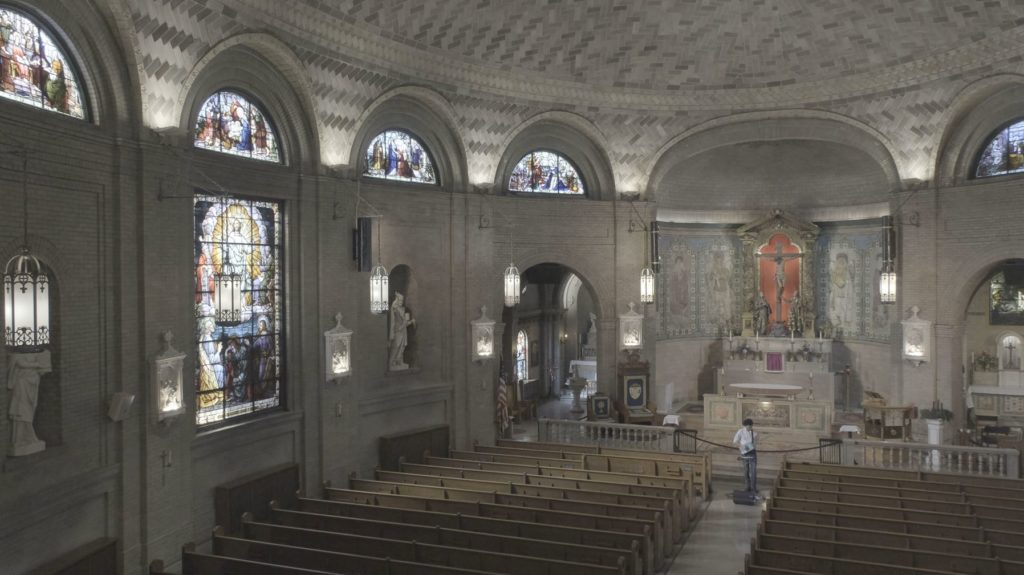A Clemson architecture major has combined his passion for architecture and musical talent into a one-of-a-kind research project to capture the musical essence of great works of architecture.
Michael Salois is a senior architecture major with a minor in music. He came up with the idea to create original compositions that would be inspired by and performed in two of his favorite spaces: the High Museum of Art in Atlanta and the Basilica of St. Lawrence in Asheville, NC. The project is titled, “Sound and Space.”
“Music was my first love for a long time before I discovered architecture,” Salois said. His journey in music began with band while he was in the fifth grade growing up in Lexington, SC, and then his musical path took its own course.
“I play whatever instruments I can get my hands on. I’ll play everything, but not anything at a particularly high level of expertise,” he explains. Over time, he developed a knack for creatively combining sounds—both environmental and instrumental—into his music.
In Fall 2021, Salois presented his proposal for an independent study to Associate Professor Dustin Albright in the School of Architecture. While presenting a musical composition project for an architecture study may sound unusual, Albright jumped at it.
“In the previous Spring semester, I had a couple of great experiences working with two different students on their directed studies. So, I was primed, in a sense, and very open to working with Michael, whom I knew to be very thoughtful and creative,” said Albright, who has had experience designing musical performance spaces. “I was really intrigued by Michael’s desire to make music for very particular spaces, music created in response to the architecture. It was, for me, another form of design.”
Salois said he approached the project as a “back and forth” between himself and the buildings. He chose both spaces based on their architectural significance and because they complement each other.
“They are both lofty and have an effect on sound, and they are both just inspiring spaces to be in,” he said. “But the High Museum with the big atrium where the sunlight pours through, and then the dark moodiness of the basilica, the two spaces are almost polar opposites in terms of lighting and the energy of the ways people use them.”
He began with a trip to each location to record ambient sounds. At the gallery, the sounds included elevator chimes, footsteps, car horns and the hum of the air conditioning units. At the basilica, he recorded the clicking of candle lighters, dripping water and a child playing.
When he began to compose the music, he directly incorporated those ambient sounds into the piece. For example, in the St. Lawrence Basilica piece, a child’s yell is autotuned and incorporated into the melody. For the High Museum, sampled door slams serve as percussive elements. The last step of the project was to return to each location for a performance that would mix live instrumentation with pre-recorded sounds. In the sleek, modernist museum, he performed on an electronic clip-launching machine. In the basilica—an example of Spanish Baroque architecture nestled in the Smoky Mountains—he managed to evoke the sounds of high church music on a cigar box guitar.

“It’s something that was played historically in the Appalachian region, so I thought it was a perfect way to tie the music to this particular place,” Salois said.
The result is a recording that Salois describes as a “feedback loop:” ambient noises from the space incorporated into music inspired by the space and recorded in the space’s unique acoustics.
“I am really impressed and proud of what Michael was able to do and create musically while learning and adapting along the way,” Albright said. “There is something really captivating about the videos showing him, by himself, standing at a distance in these huge and impressive spaces, and totally filling those spaces with the music he’s made.”
The project reflects the College of Architecture, Arts and Humanities’ emphasis on creative interdisciplinary research, an approach to creativity that Salois and Albright both share.
“A lot of what I learn from going between the two [disciplines] is a workflow,” Salois explained. “Architecture is a very iterative process, so we make models, we make sketches, and then we keep doing that, sort of using the same ideas going forward. I approach music in a similar fashion.”
“On the one hand, as designers of places, we are constantly having to put ourselves in other people’s shoes, working to learn about and appreciate the unique interests, occupations, needs and desires of those who will inhabit these places. This requires empathy and imagination, and, often, research into other disciplines,” Albright said. “On the other hand, I think it’s intrinsically valuable to cultivate interests that get us outside of our primary work. It provides balance to our lives and can occasionally help us to make connections and inspirations that frame our work in new ways.”
After graduation, Salois plans to attend University of Michigan to pursue a Master of Architecture degree. Still, he says he is hoping to do a final project focused on music before leaving the area that captures the spirit of the Upstate and the southern Appalachian region.
“As I prepare to go off to grad school it’s a good time to define this region and this part of my life in some way,” he said.
Get in touch and we will connect you with the author or another expert.
Or email us at news@clemson.edu

